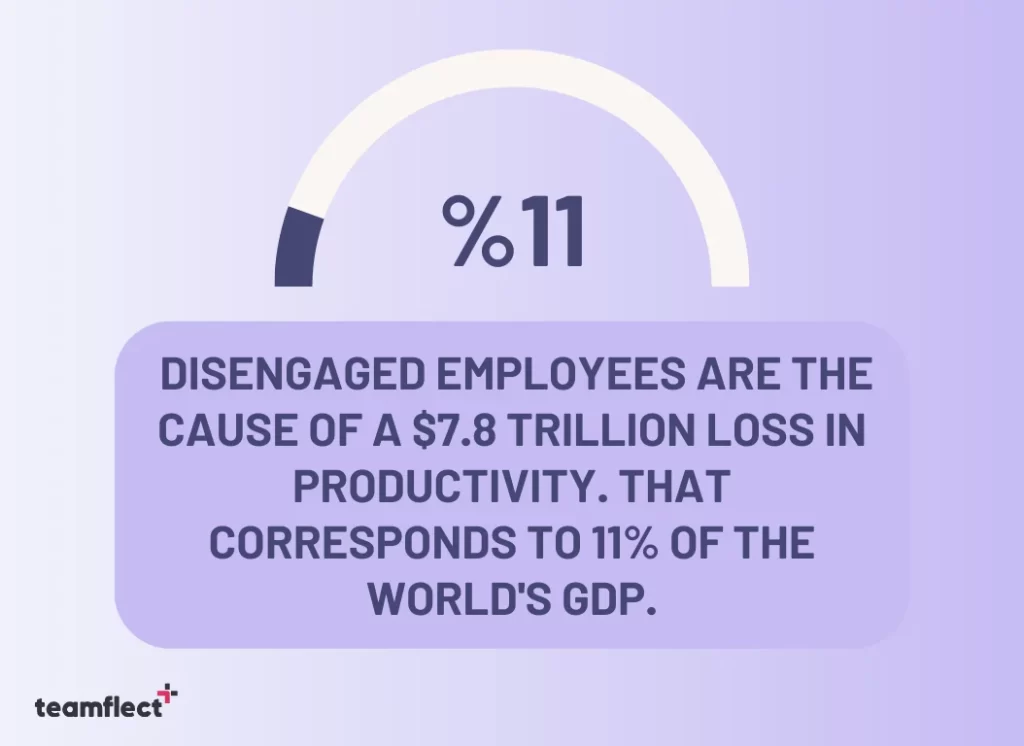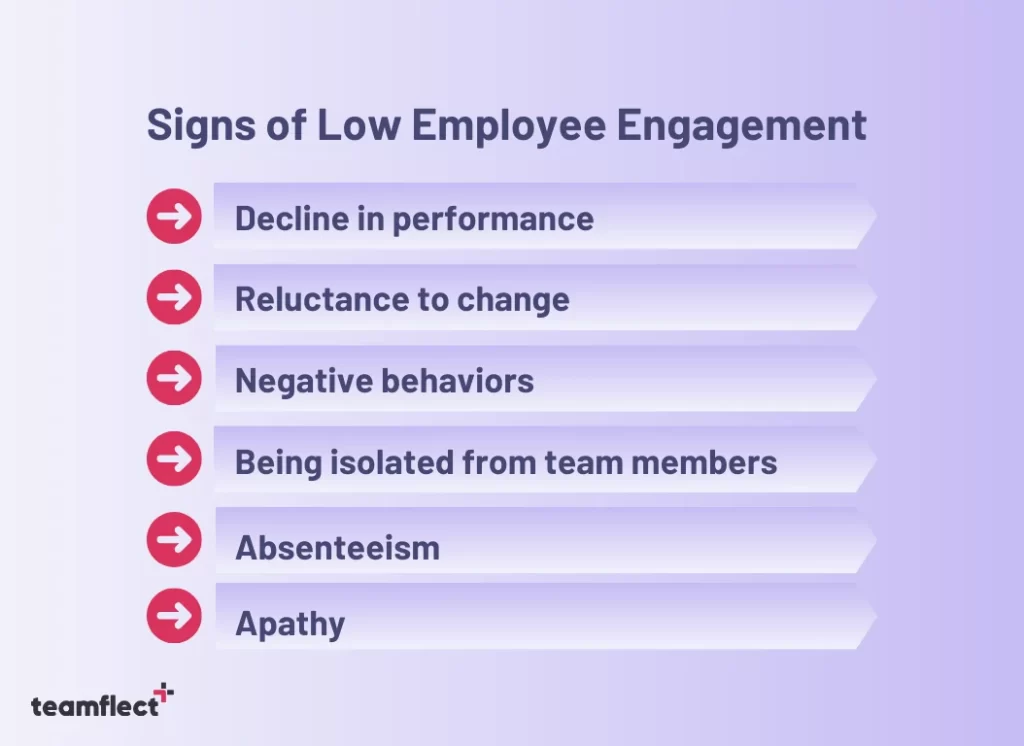Identifying low employee engagement can be more difficult than it seems because your employees might not be verbal about the issues they have been facing in the workplace.
You need to find out who is disengaged and what can be done about this problem because low employee engagement will negatively affect your bottom line.
Here are some statistics that demonstrate the relationship between low employee engagement and its costs to the economy:

- According to Gallup’s State of the Global Workplace: 2022 Report, disengaged employees are the cause of a $7.8 trillion loss in productivity. That corresponds to 11% of the world’s GDP.
- According to a Gallup poll, disengaged workers cost the US economy $450–500 billion annually.
- Workest reports that 63.3% of businesses find it more difficult to keep talent than to recruit them.
- According to Employee Benefit News (EBN), to replace an employee who leaves, an employer needs to spend 33% of an employee’s annual salary.
The statistics above demonstrate how important employee engagement is. So, let’s explore the costs and signs of low employee engagement further and see what can be done to tackle this problem.
Table of Contents
What is Low Employee Engagement?
Low employee engagement is an indicator that illustrates your employees are not passionate about their jobs and they feel like they don’t belong to their workplace. They frequently become unproductive, and might also be searching for a new job.
An engaged employee makes a difference in the company by how they execute their job. Disengaged employees, on the contrary, will have difficulties performing well and making meaningful contributions at work.
What Are The Reasons For Low Employee Engagement?
To successfully address the low employee engagement problem, companies need to understand the causes. So, we are listing the most common causes of low engagement below.
1. Ineffective leadership
It’s difficult to feel driven and completely invested in one’s job when employees feel micromanaged and get discouraged from talking about ways to make improvements.
When this happens, leaders tend to lack competence in inspiring innovation and delegating tasks. Here are some of the indicators of poor leadership.
- Giving limited autonomy to their employees..
- Micromanaging.
- Inability to motivate.
- Lack of guidance.
- Lack of vision.
These variables may cause low employee engagement and prevent the workers from performing well.
2. Lack of effective communication
Lack of effective communication is a must in any kind of relationship including work relationships. When it’s not established employees will be frustrated and disengaged.
For example, imagine a company that is going to launch a new product. If the marketing team, despite their efforts to create a great campaign, is not communicating with the sales team who will talk to the customers, there will be confusion and frustration in the sales team. And this frustration will lead to low employee engagement.
3. Absence of recognition
One of the main reasons why employees are leaving their jobs is a lack of recognition. But according to 81% of company leaders, recognition is not one of their top corporate priorities.
At the fundamental level, organizations that prioritize recognition display praise, and appreciation regularly and genuinely. When a company includes recognition as a practice to improve employee engagement, employees believe that their contributions matter.
4. Limited growth opportunities
Employee engagement is heavily dependent on professional development because it keeps employees interested, satisfied, and enthusiastic. But many companies struggle to offer their staff members meaningful development opportunities.
Employees who experience stagnation in their positions or who do not have the chance to acquire new skills are likely to lose interest in their job. This will result in lower productivity and performance in addition to higher employee turnover.
5. Inadequate work-life balance
No one wants to be constantly preoccupied with work. People need time to unwind and spend time with their family and friends. When the work-life balance is inadequate, your employees will feel unhappy at work and this will eventually result in a lack of engagement.
The Saïd Business School at Oxford University has conducted research in partnership with the multinational British telecoms company BT and has found a link between happiness and productivity. According to the study, happiness functions as an accelerator for productivity and happy employees are 13% more productive.
So to improve employee engagement and ultimately productivity, employers need to make sure that they are striking a balance between work responsibilities and employees’ personal lives.
6. Toxic workplace
Toxic workplaces may be the culprit to blame when it comes to low employee engagement. The toxicity can be caused by several things, such as poor communication, absence of transparency, micromanagement, inconsistent leadership, and favoritism.
When workers have lost confidence in their managers due to their toxic traits, it can affect team morale and cohesion, and decrease employee engagement.
What are the Costs of Low Employee Engagement?
1. Decline in productivity
A decline in productivity is among low employee engagement’s most detrimental consequences. Employees are unlikely to put forth the time and effort necessary to complete their assignments if they are disengaged.
In addition, they might lack motivation to take on new responsibilities and they might not want to improve their abilities, which would prevent the company from achieving its goals.
2. High absenteeism
Low employee engagement is the main factor contributing to high absenteeism at work.While highly engaged work environments report a 41% decrease in absenteeism workers who lack commitment to their jobs are more likely to be absent from work.
3. Increase in turnover rates
One of your good employees might be leaving your company because they are disengaged.
Work units with scores in the top quartile of their organization in employee engagement double their odds of success in contrast with those within the bottom quartile (based on a combination of metrics related to finances, customers, retention, safety, quality, shrinkage, and absenteeism).
The success rate for those in the 99th percentile is almost five times greater than for those in the first percentile.
4. Negatively affects your bottom line
If an employee or team isn’t motivated and invested in their work, it will show in their performance and productivity levels.
Low productivity suggests that employees aren’t making the most of their skills, increasing the cost of the company’s human resources and having a direct, detrimental effect on its bottom line. This can be a big obstacle to business expansion.
A high turnver rate is one of the biggest expenses a low employee engagement can have on a company’s profitability. Moreover, it can be difficult to find new talent in a competitive marketplace. Losing employees can have a significant financial impact on your bottom line.
Signs of Low Employee Engagement

The higher the number of these signs, the more likely that your company will suffer a financial loss.
1. Decline in performance
A decline in performance is one of the initial signs of low employee engagement. And there are numerous ways in which this might manifest.
An employee who usually holds very high standards for their work may start missing deadlines or making careless errors. Your best employee might end up performing like one of your average employees.
2. Reluctance to change
Disengaged workers are the ones who adjust more slowly, whether it’s supporting a new company initiative or adhering to a new procedure. They will glorify earlier methods of doing things. In addition, they will vocally express their reluctance to change.
Also, their tendency will be to ignore potential advantages in favor of paying attention to the negative aspects of the change.
This might happen because change requires effort and disengaged employees frequently lack the passion and enthusiasm to overcome obstacles that come with change.
3. Negative behaviors
A disengaged employee may lose their temper over the smallest things because they are less compassionate and cognizant of others. Furthermore, they might generally view work negatively and often dismiss the ideas of others.
This may result from a worker feeling unheard, underappreciated in their position, or having issues outside of work. In both instances, it’s important to make an effort to tackle the root causes before they worsen.
4. Being isolated from their team members
Another indication of low employee engagement is when employees begin isolating themselves from their colleagues and start to put themselves first.
This might show up as a reluctance to work together with team members, a lack of involvement in meetings, or perhaps as avoiding company events.
5. Absenteeism
Consistent absences from the workplace may indicate disengagement. Asking an employee about their feelings and providing them with the support they require to tackle any problems is always important if they display absenteeism.
6. Apathy
Apathy is something that might be regarded as more severe than negativity. Employee disengagement can be observed when employees have no interest in their jobs. They simply don’t care enough to be even angry.
This can be observed in an employee’s unwillingness to defend their positions in discussions or their indifference.
How to Solve Low Engagement Problem
1. Strengthen communication
One of the most important elements to keep in mind when trying to increase employee engagement is communication. Because, communication is crucial particularly at work.
Creating connections both inside and outside of the office can be a great strategy for enhancing communication across your company.
People with similar interests may form bonds with employees from various departments and build relationships that could not possibly exist without organizing events in the workplace.
If you are working remotely, you may also consider using software that will enable your employees to connect and remove communication barriers.
There various remote work apps that you can use to increase employee engagement. By facilitating communication and collaboration these helps can help you solve the low engagement problem effectively.
However, Teamflect is the best remote team management software if your company already uses Microsoft Teams or other Microsoft Office applications in your daily operations.
2. Offer opportunities for development
It’s one of the musts to offer learning, performance mentoring opportunities, and an established career path to your employees. According to a recent Gallup survey, opportunities for career advancement have been the main reason employees quit.
To make sure their teams’ professional goals are being accomplished, managers must maintain an open channel for feedback with their employees.
Think about providing training programs to encourage career growth, particularly when considering how to boost employee engagement in the workplace.
3. Use employee engagement software
Employee engagement software is used for measuring, monitoring, and improving engagement among employees.
Although monitoring engagement may be challenging, there are plenty of fantastic employee engagement survey tools that can help!
When you use employee engagement software, you can recognize your employees’ efforts and reward them. Employee engagement software also helps you to monitor the progress being made by your team members. These are the best employee engagement software that your organization can benefit from.
But if you are part of a team that uses Microsoft Teams on a daily basis, then the best option for you is:
Teamflect

Compared to other tools, using Teamflect makes it much easier to build engaged teams. Because it provides a range of features and strategies that could help you improve communication, create a community of praise and recognition, and build a working environment of continuous feedback and professional growth.
Teamflect’s features include but aren’t limited to:
- Employee engagement surveys.
- Performance review templates.
- Customizable feedback templates
- Power BI Reports that provide users with important organization-specific insights.
- One-on-one meetings that enable note-taking, task assignment, and feedback tools.
- Automated review cycles that can be customized, with built-in performance review templates
That is why Teamflect is the best software for employee engagement in the Microsoft Teams ecosystem. But, you can see for yourself! Teamflect is completely free for up to 10 users. No signing up required!



